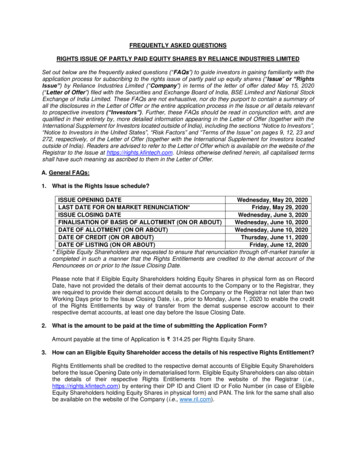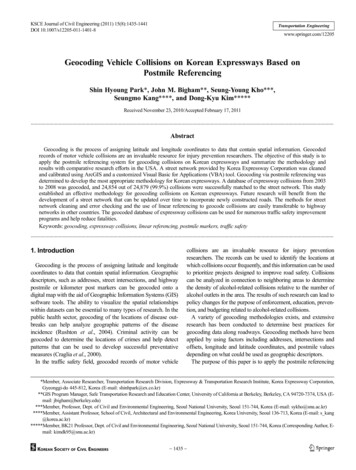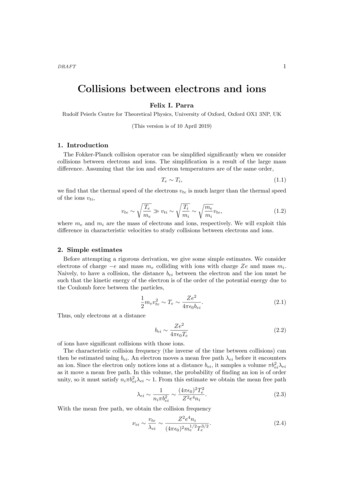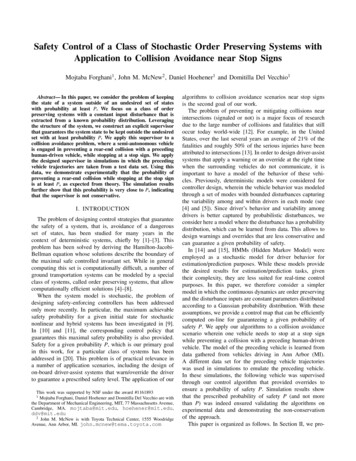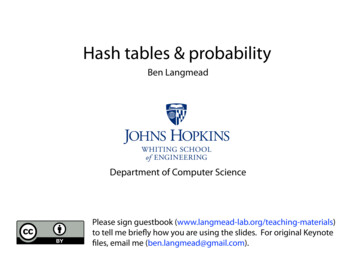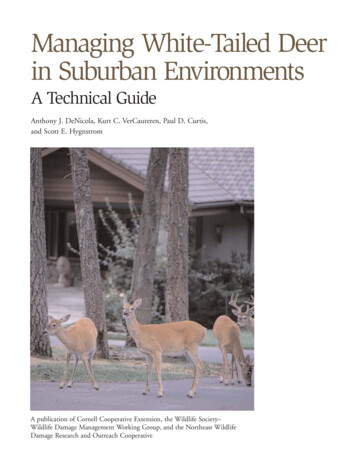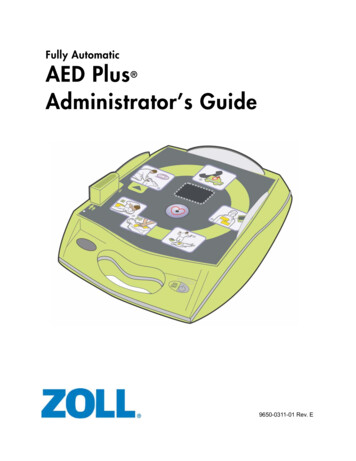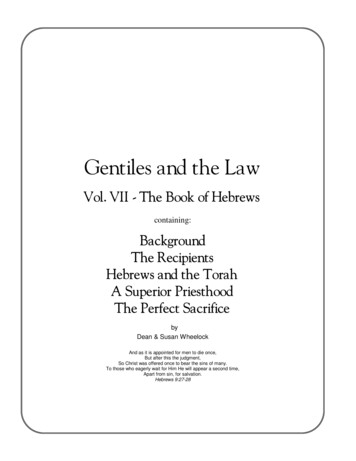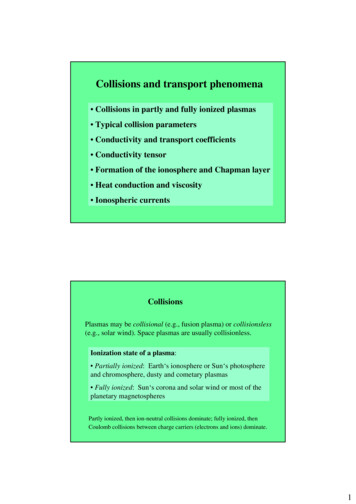
Transcription
Collisions and transport phenomena Collisions in partly and fully ionized plasmas Typical collision parameters Conductivity and transport coefficients Conductivity tensor Formation of the ionosphere and Chapman layer Heat conduction and viscosity Ionospheric currentsCollisionsPlasmas may be collisional (e.g., fusion plasma) or collisionsless(e.g., solar wind). Space plasmas are usually collisionless.Ionization state of a plasma: Partially ionized: Earth‘s ionosphere or Sun‘s photosphereand chromosphere, dusty and cometary plasmas Fully ionized: Sun‘s corona and solar wind or most of theplanetary magnetospheresPartly ionized, then ion-neutral collisions dominate; fully ionized, thenCoulomb collisions between charge carriers (electrons and ions) dominate.1
Collision frequency and free pathThe neutral collision frequency, νn, i.e. number of collisionsper second, is proportional to the number of neutral particlesin a column with a cross section of an atom or molecule, nnσn,where nn is the density and σn πd02 ( 10-20 m2) the atomiccross section, and to the average speed, υ ( 1 km/s), ofthe charged particle.The mean free path length of a charged particle is given by:Coulomb collisions ICharged particles interact via the Coulomb force over distances muchlarger than atomic radii, which enhances the cross section as compared tohard sphere collisions, but leads to a preference of small-angle deflections.Yet the potential is screened, and thus the interaction is cut off at theDebeye length, λD. The problem lies in determining the cross section, σc.Impact or collision parameter, dc, and scattering angle, γc.2
Coulomb collisions IIThe attractive Coulomb force exerted by an ion on an electron ofspeed ve being at the distance dc is given by:This force is felt by the electron during the fly-by time tc dc/υe andthus leads to a momentum change of the size, tc FC , which yields:For large deflection angle, γc 90o, themomentum change is of the order of theoriginal momentum. Inserting this valueabove leads to an estimate of dc, which is:Coulomb collisions IIIThe maximum cross section, σc πdc2, can then be calculated andone obtaines the electron-ion collision frequency as:Taking the mean thermal speed for ve, which is given by kBTe 1/2 meve2,yields the expression:The collision frequeny turns out to be proportional to the (-3/2) power ofthe temperature and to the density. A correction factor, lnΛ, still has to beapplied to account for small angle deflections, where Λ is the plasmaparameter, i.e. the number ofparticles in the Debye sphere.3
Typical collision frequencies for geophysical plasmasCoulomb mean free path lengths in space plasmas4
Coulomb collisions in the solar wind10 1010 7Solarw ind(1A U )10T e (K )10 31-2 10 610 5λ e (km )10100010 7Param eterN e (cm -3 )C hrom o C orona-sphere (1R S )N is the number of collisions between Sun and Earth orbit. Since in fast wind N 1, Coulomb collisions require kinetic treatment! Yet, only a few collisions (N 1) remove extreme anisotropies! Slow wind: N 5 about 10%, N 1 about 30-40% of the time.Plasma resistivityIn the presence of collisions we have to add a collision term in theequation of motion. Assume collision partners moving at velocity u.In a steady state collisional friction balances electric acceleration.Assume there is no magnetic field, B 0. Then we get for the electronswith ions at rest:Since electrons move with respect to the ions, they carry the currentdensity, j -eneve. Combining this with the above equation yields,E η j, with the resistivity:5
Conductivity in a magnetized plasma IIn a steady state collisional friction balances the Lorentz force. Assumethe ions are at rest, vi 0. Then we get for the electron bulk velocity:Assume for simplicity that, B Bez.Then we can solve for the electronbulk velocity and obtain thecurrent density, which can incomponents be written as:Here we introduced the plasmaconductivity (along the field).The current can be expressed in the form of Ohm‘s law in vectornotation as: j σ E, with the dyadic conductivity tensor σ .Conductivity in a magnetized plasma IIFor a magnetic field in z directionthe conductivity tensorσ reads:When the magnetic field has an arbitrary orientation, the current densitycan be expressed as:The tensor elements are thePedersen,σD, the Hall,σH,and the parallel conductivity.In a weak magnetic field theHall conductivity is smalland the tensor diagonal, i.e.the current is then directedalong the electric field.6
Dependence of conductivities on frequency ratio ωge νc, electrons arescattered in the fielddirection beforecompleting gyration. ωge νc, electronscomplete many gyrocirclesbefore being scattered - electric drift prevails.Formation of the ionosphereThe ionosphere is thetransition layer between theneutral atmosphere andionized magnetosphere.Solar ultraviolet radiationimpinges at angle χν, is absorbedin the upper atmosphere andcreates ionization (also throughelectron precipitation). I is theflux on top of the layer.The ionosphere is barometricallystratified according to the density law:H is the scale height, defined as, H kBTn/mng, with g being thegravitational acceleration at height z 0, where the density is n0.7
Diminuation of ultraviolet radiationAccording to radiative transfer theory, the incident solar radiation isdiminished with altitude along the ray path in the atmosphere:Here σν is the radiation absorption cross section for radiation(photon) of frequency ν. Solving for the intensity yields:This shows the exponential decrease of the intensity with height, asis schematically plotted by the dashed line in the subsequent figure.Formation of the Chapman layerThe number of electron-ion pairs locally produced by UV ionization, thephotoionization rate per unit volume qν(z), is proportional to theionization efficiency, κν , and absorbed radiation: qν(z) κν σνnnI(z).This gives the Chapman production function, quoted and plotted below.8
Electron recombination and attachmentRecombination, withcoefficient αr, andelectron attachment, βr,are the two major lossprocesses of electronsin the ionosphere.In equilibrium quasineutrality applies:ne niThen the continuityequation for ne reads:Transport coefficients: Heatconduction and viscosityElectrons in a collision-dominated plasma can carryheat in the direction of the temperature gradient,Qe - κe TeFourier‘s law:κe 5nekB2Te/(2meνc )Ions in a collision-dominated plasma can carrymomentum in the direction of velocity gradients(shear, vorticity, etc.),Viscous stresses:Πi - ζi ( Vi ( Vi)T )ζi nikBTi/νc9
Ionospheric currentsIons and electrons (to a lesser extent) in the E-region of the Earthionosphere are coupled to the neutral gas. Atmospheric winds andtidal oscillations force the ions by friction to move across the fieldlines, while electrons move differently, which generates a current- „dynamo“ layer driven by winds at velocity vn.Ohm‘s law is modified accordingly:Current systems: Current system created by atmospheric tidal motions Equatorial electrojet (enhanced effective conductivity)10
The collision frequeny turns out to be proportional to the (-3/2) power of the temperature and to the density. A correction factor, lnΛ, still has to be applied to account for small angle deflections, where Λis the plasma parameter, i.e. the number of particles in the Debye sphere. 4 Typical collision frequencies for geophysical plasmas Coulomb mean free path lengths in space plasmas. 5 .


